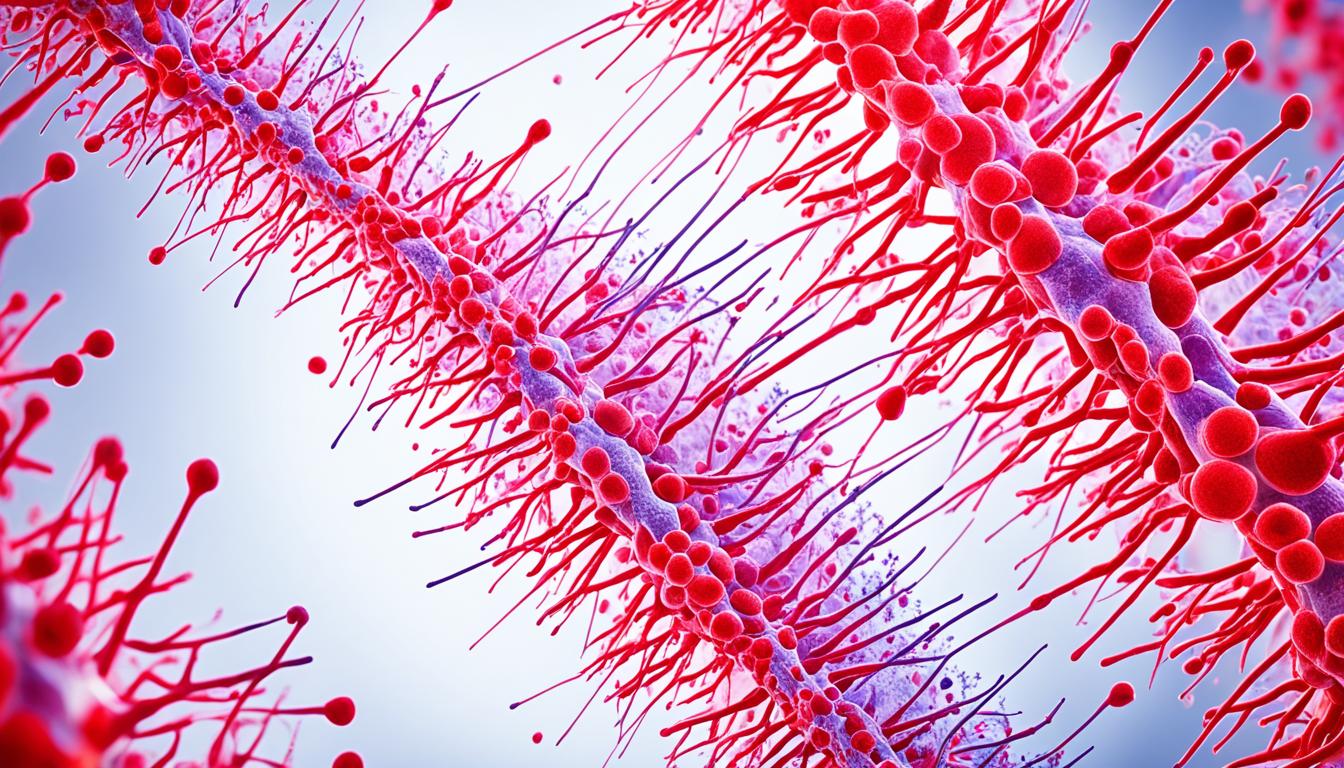Scarlet fever, known as scarlatina, is caused by the bacterium Group A Streptococcus (GAS). It mainly affects children aged 5 to 15. It shows up with a pink-red or discolored rash 1 to 4 days after infection. Other symptoms are a sore throat, high fever, headache, and swollen neck glands.
This disease spreads through respiratory droplets or touching infected people or objects. A doctor diagnoses it with a physical exam, throat swab, and sometimes a blood test. Starting antibiotics early, like penicillin, is important to avoid serious harm.
In some cases, scarlet fever can cause kidney failure or severe infections. Stem cell therapy’s role in treating scarlet fever is not well known.
Key Takeaways:
- Scarlet fever mainly affects children between 5 and 15.
- Its symptoms include a pink-red rash, sore throat, high fever, and others.
- It spreads through respiratory droplets and touching infected people or objects.
- A doctor confirms the diagnosis with a few tests.
- Starting antibiotics early is crucial to prevent serious problems.
Symptoms of Scarlatina: Recognizing the Signs of Scarlet Fever
Scarlatina, also called scarlet fever, symptoms start 1 to 4 days after catching it. It often begins with a red, sore throat. You might see white or yellow patches in the throat. A high fever of over 101 degrees Fahrenheit (38.3 degrees Celsius) and chills are also common during this time.
After about 12 to 48 hours, a rash appears. The rash starts as red blotches. It turns into a pink-red rash that looks like sunburn. This rash feels like rough sandpaper.
It can spread over the body but usually avoids the face. Even so, the patient’s cheeks might look flushed. The area around their mouth may seem pale. When the rash is pressed with a glass, it may turn white for a short moment.
Other symptoms could include trouble swallowing, feeling sick, a headache, and itching. Nausea, vomiting, and a lack of hunger are possible. The patient might also feel stomach pain, see blood vessels where the skin folds, and has swollen neck glands. A whitish tongue coating may change to the tongue looking like a red and swollen strawberry.
Sometimes, those with scarlatina might have muscle aches, throw up, or have diarrhea. It’s important to check for possible severe conditions like toxic shock syndrome.
Common Symptoms of Scarlatina:
- Red, sore throat with white or yellowish patches
- High fever above 101°F (38.3°C) and chills
- Distinctive pink-red rash resembling sunburn
- Rough rash texture like sandpaper
- Rash spreads to ears, neck, elbows, inner thighs and groin, chest, and other body parts (but usually not the face)
- Flushed cheeks and pale area around the mouth
- Rash briefly turns white when pressed with a glass
- Difficulty swallowing
- Feeling unwell
- Headache
- Itching
- Nausea and vomiting
- Loss of appetite
- Abdominal pain
- Broken blood vessels in the folds of the body
- Swollen and tender neck glands
- White coating on the tongue followed by a red and swollen “strawberry” tongue
Comparison of Scarlet Fever and Common Cold Symptoms
| Symptoms | Scarlet Fever | Common Cold |
|---|---|---|
| Sore throat | ✓ | ✓ |
| High fever | ✓ | – |
| Headache | ✓ | ✓ |
| Swollen neck glands | ✓ | – |
| Rash | ✓ | – |
| Cough | ✓ | ✓ |
| Runny nose | – | ✓ |
| Sneezing | – | ✓ |
| Congestion | – | ✓ |
Causes, Transmission, and Diagnosis of Scarlatina
Scarlatina, or scarlet fever, is caused by the bacterium Streptococcus pyogenes. It spreads mainly through the air when someone infected coughs or sneezes. You can also get it by touching surfaces with the bacteria and then touching your face. Sometimes, direct skin contact with someone who has a streptococcal skin infection causes it too.
Being close to someone with scarlatina, like sharing towels or clothes, raises your risk of getting it. But what’s tricky is some people can have the bacteria without showing any signs. This makes keeping clean, especially washing your hands often, very important to avoid spreading or catching the disease.
Diagnosing scarlatina needs a doctor or nurse to check you over. They might do a throat swab, where they take a sample from the back of your throat. This sample is checked in a lab to look for the Streptococcus pyogenes bacteria. They might also suggest a blood test to see if you have any infection-fighting proteins that suggest you’re sick. Finding out quickly if someone has scarlatina is key to treating it well.

